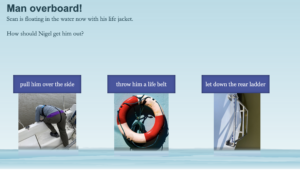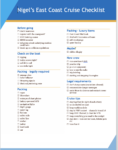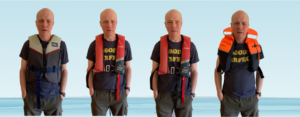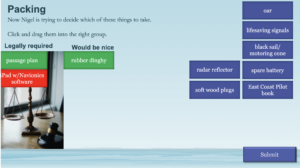Sea Sailing Training
- Responsibilities: Instructional Design, eLearning Development
- Target Audience: Members of a sailing club, generally older men
- Tools Used: Articulate Storyline, Powerpoint
- Budget: £0
- Year: 2021
Learning objectives
By the end of the course the participants will be able to:-
- identify legal requirements for what to take on a sea voyage, in order to use a VHF radio abd what is required of sailors during a sea voyage
- correctly wear a life jacket
- describe the plan for the trip
- recall a sensible list of items to take and why
- follow useful tips for what to do on the trip
Background
This is an annual event and the briefing had always been given face-to-face. However, in 2021 this was impossible so it was conducted via Zoom. Although this worked well it was a very long session and it is established that many people find Zoom meetings more tiring than face-to-face ones and there is more likelihood of things being forgotten. Therefore I built this course so that members of the club could follow it at home at their own pace.
The hope is that before future trips members can do this course first and then bring any questions to an in-person meeting to make things mroe streamlined.
Design Process
Preparation

There was an 89-slide Powerpoint and an 8-page script for the briefing which had been prepared for the Zoom meeting. This had a lot of pictures that were amusing and engaging but many were not Copyright-free and violated Mayer’s coherency principle.

This was a lot of information in there and the structure was not entirely clear so I rearranged it into chronological stages to match what would happen:
- before going
- packing
- getting on board
- on the cruise.
Talking to the SME
Next, I talked to the SME who always gave the briefing and checked what problems there had been on the cruise before and which things were difficult for people to remember in order to see if there was anything that needed to be added to the list of topics.
We agreed that someone falling overboard was the biggest danger so I added a Man overboard! piece of scenario-based learning to cover this in more detail.

It also became clear that some members of the club were new or had not done the cruise before so a full course was useful for them, while others had done it many times before. We therefore made a checklist that newer members could download after completing the course and more experienced members could download instead of doing it. This list could be printed out and checked off as they were preparing.

Making a prototype
I made a prototype in Powerpoint in order to show roughly what the slides would look like, the order they would come in, and how the interactions would work. I showed this to the SME and made adjustments after feedback.
For example, some things that people take are of doubtful use on the cruise so initially, the participants sorted objects into legally required, a good idea and questionable. After looking at the prototype we agreed to make it just two columns and explain in the next slide that dinghies are no longer popular and that nobody knows how to find a black sailing/motoring cone.
Important considerations after consultation
- stress that this is not club advice and that the club is not liable
Solution: A disclaimer at the beginning explaining this, and personallising the course all the way through, ie Nigel packs these things rather than These are the things you must pack.
Helpfully this helped to keep the course in line with Mayer’s personalisation principle, which has also been shown to aid learning.
- no budget for images
Solution: Use pictures of Nigel’s actual boat, of myself wearing a life jacket etc.

First draft
I made a first draft in Storyline and trialled it on the SME. I was able to watch and see what seemed difficult and he was able to proofread and check for accuracy.
After this we:-
- removed a third column quesitonable from the packing sorting activity and added a slide with information about each item available by hovering over it
- decided that the safest course of action in the given scenario was to call the coastguard
- corrected some typos
Second draft
After these changes, we uploaded the course and sent it to experienced members of the sailing club. Based on their feedback we:
- amended the sentence fragment about the VHF course from “you must do this before using the radio” to “someone on board needs to have passed this”
- removed a final slide about responsibilities on the cruise that people found unnecessary
- added instant feedback to a sorting exercise which people found a bit difficult

Final version
The final version was then sent to all members of the club and feedback was invited. The feedback came via email and was overwhelmingly positive.
